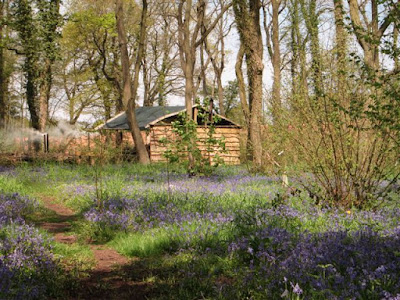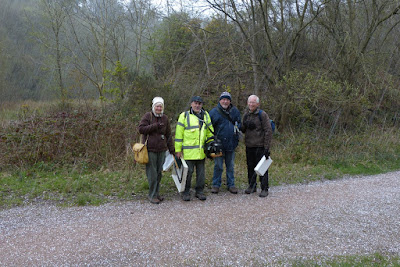We were lucky with the weather, bright sunshine although
breezy for most of the day. The Moat is
a local nature reserve adjacent to a church with an amazing gothic style tower
in the centre of Shawbury. The moat used
to surround a medieval manor house and was a domestic, rather than a military,
installation.
Our first sighting was of a male brimstone, which boded
well for the day. It was only 10:30 and
the butterflies were already flying.
As we clambered down the bank of the old moat we were
pleased to see English bluebells with their narrow one-sided bells drooping
downwards. On returning to the circular
path an anxious local stopped to chat.
She wondered what we were doing and was pleased when we explained we
were recording the flora and fauna of the site.
It’s good to know that local people are taking an interest in their
local wildlife patch.
A male and two female blackcaps spent the morning
serenading us, flitting from tree to tree, obviously pleased that spring
weather was here at last.
On the banks meadow foxtail was very prevalent with
occasional clumps of Yorkshire fog. Also
in abundance were green alkanet, a garden escapee, and garden daffodils. Together with lesser celandine and ground ivy
the grassy banks were colourful. Down
near the waters edge was wild garlic and common comfrey
A few sightings during the morning kept us recording but
we were not inundated, just steady. A
micro moth, Stigmela aurela, was identified plus a 10 spot ladybird. There were many sightings of orange tips and
of a small white butterfly, with a large white recorded just before lunch. A common carder bee was spotted along with
cream spot ladybird.
Near the pool area were wavy bittercress, yellow
iris, creeping buttercups and slender speedwell. Small clumps of cuckoo flower, lords and
ladies and wood anemone were found and a common froglet leapt in the long grass.
We spent lunchtime sitting on a sunny bench, looking
across the rough meadow with a pathway winding around it and imagining what it
must have been like before the trees were felled. We had seen a variety of trees in the
morning, including oak, elder, beech, silver birch, holly and hawthorn.
As we looked across the meadow we saw a stand of
tall, grey barked trees and on closer examination saw the lines of diamond
shaped pits on the bark. The trees
proved to be grey poplar, a hybrid between aspen and white poplar. These are commonly planted as wind breaks as
they sucker freely and form thickets.
The sun continued and we paused by an old felled
tree to examine the bark beetle galleries.
In so doing, we disturbed a tiny 22 spot ladybird and I then spent time
photographing an impressive oak tree.
Nearby was a bench with a hyacinth in full bloom peeping from beneath
it, not what you would expect to see.
Small tortoiseshell and peacock butterflies were spotted
on our walk back towards the car park, along with large groups of marsh
marigolds in the water logged sections of the field. Then we bagged a dock bug, our last find of
the day, which concluded with us admiring the impressive doorway and gargoyles
of the church.
A very pleasant day spent at Shawbury Moat in the spring
sunshine.
Margaret Mitchell













































































